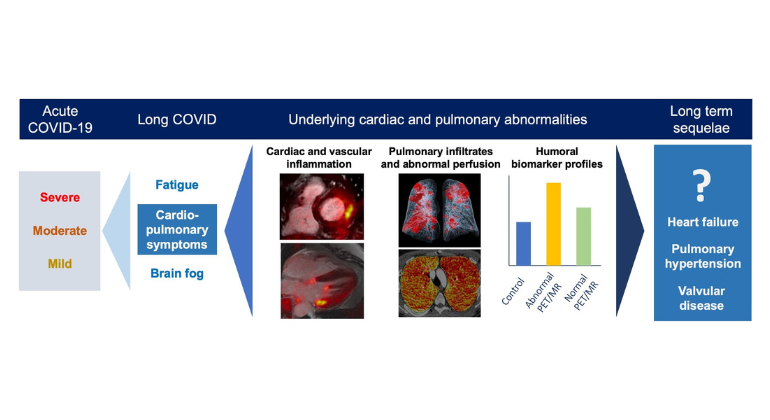2025-05-06 マウントサイナイ医療システム (MSHS)

<関連情報>
- https://www.mountsinai.org/about/newsroom/2025/long-covid-may-cause-long-term-changes-in-the-heart-and-lungs-and-may-lead-to-cardiac-and-pulmonary-diseases
- https://jnm.snmjournals.org/content/early/2025/04/30/jnumed.124.268980/tab-figures-data
長期COVID患者におけるPET/MRIおよびDECT画像上の持続的な心血管および肺の異常の有病率 Prevalence of Persistent Cardiovascular and Pulmonary Abnormalities on PET/MRI and DECT Imaging in Long COVID Patients
Maria Giovanna Trivieri, Ana Devesa, Philip M. Robson, Sonali Bose, Busra Cangut, Steve Liao, Audrey Kaufman, Renata Pyzik, Valentin Fauveau, Jamie Wood, Aaron Shpiner, Edwin Yoo, Sarayu Huang, Claudia Calcagno, Venkatesh Mani, Sahityasri Thapi, Johanna Contreras, Kai Nie, Seunghee Kim-Schulze, Sacha Gnjatic, Miriam Merad, Munir Ghesani, David Putrino, Adam Jacobi, Donna Mancini, Charles Powell and Zahi A. Fayad
Journal of Nuclear Medicine Published:April 30, 2025
DOI:https://doi.org/10.2967/jnumed.124.268980
Abstract
The objective of this study is to describe the prevalence of inflammatory cardiopulmonary findings in a prospective cohort of long coronavirus disease (LC) patients.
Methods: Subjects with a history of coronavirus disease 2019 infection, persistent cardiopulmonary symptoms 9–12 mo after initial infection, and a clinical assessment compatible with LC underwent cardiopulmonary 18F-FDG PET/MRI, dual-energy CT (DECT) of the lungs, and plasma protein analysis (subgroup). A control group that included subjects with a history of acute severe acute respiratory syndrome coronavirus 2 infection but without cardiopulmonary symptoms at recruitment was also characterized.
Results: Ninety-eight patients (median age, 48.5 y; 47% men) were enrolled. The most common LC symptom was shortness of breath (80%), and 27% of participants were hospitalized. Of the subjects, 90% presented abnormalities in DECT, with 67% and 59% of participants demonstrating pulmonary infiltrates and abnormal perfusion, respectively. PET/MRI was abnormal for 57% of subjects: 24% showed cardiac involvement suggestive of myocarditis, 22% presented uptake reminiscent of pericarditis, 11% showed periannular uptake, and 30% showed vascular uptake (aortic or pulmonary). There was no myocardial, pericardial, periannular, or pulmonary uptake on the PET/MRI scans of the control group (n = 9). Analysis of plasma protein concentrations showed significant differences between the LC and the control groups. Lastly, the plasma protein profile was significantly different among LC patients with abnormal and normal PET/MRI.
Conclusion: In LC subjects evaluated up to a year after coronavirus disease 2019 infection, our results indicate a high prevalence of abnormalities on PET/MRI and DECT, as well as significant differences in the peripheral biomarker profile, which might warrant further monitoring to exclude the development of complications such as pulmonary hypertension and valvular disease.


